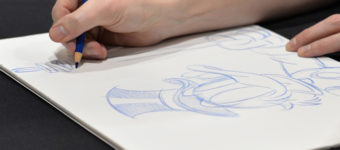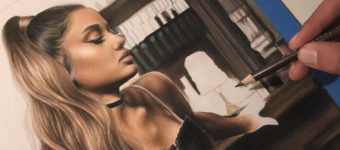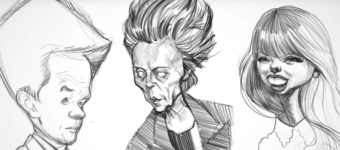
Best Caricature Art Books For Learning Exaggeration
The art of caricature can apply to any form of cartooning or illustration. It’s a means of exaggerating reality to distort certain features while remaining true to the original subject.
Learning to caricature is also about learning to see and copy. This means you’ll need to have some basic experience drawing from life to copy clearly. But you can always learn caricature as you practice and slowly improve over time.
I’ve curated the absolute best caricature books teaching the art and style of this technique. If you’re looking for a place to start or improve your existing caricature techniques then this post is sure to have something cool.
A Caricaturist’s Handbook


Author and professional caricaturist Jim van der Keyl offers incredibly valuable advice in his book A Caricaturist’s Handbook.
This should practically be required reading for anyone delving into the world of caricature. It’s only 124 pages long but it covers an immense amount of information.
You’ll get to peek into the process of a caricature artist from concept to completion. Jim shares his tips for approaching every subject to find which areas to exaggerate and play up. This includes specific visualization techniques to see form, shape, and proportions.
Later pages include a gallery of caricature work that you can study and extrapolate much of the book’s advice.
There’s no doubt that the Caricaturist’s Handbook is a great read. It’s something that you can come back to time & again to refresh your mind and pick up good habits for your workflow.
The Mad Art of Caricature!


Another in-depth book every artist should read is The Mad Art of Caricature! by Tom Richmond.
This one’s a bit longer with 175 pages covering a lot of unique tips for aspiring caricature artists. Tom has almost three decades of experience drawing caricatures and illustrations for games, movies, and magazines.
He shares lots of examples while delving into the details to explain what makes a certain caricature successful. You’ll learn about realistic exaggeration along with tips for keeping harmonious relationships between anatomical details.
Later chapters get into practical advice for selling your caricatures to magazines, print publications, or to passerbys on the boardwalk.
Tom’s book is yet another staple that all aspiring caricaturists should check out.
How to Draw Caricatures


Learning to draw and exaggerate are two very distinct skills. But Martin Pope’s book How to Draw Caricatures ties everything together with a series of techniques and exercises.
The big topics of this book focus on proportions, facial characteristics, and gestures. Early chapters explain the basics of symmetry and how to study a face.
But as you progress you’ll learn to dig into the tiny details like expressions, mannerisms, and hair styles. Attention to detail can make all the difference in the world of caricature.
You’ll learn many new techniques like drawing caricatures in profile, drawing from memory, and learning to render different body types. Each chapter includes tons of examples with many caricatures of celebrities like Will Smith, Elvis Presley, and Jack Nicholson(among many others).
Martin’s teaching style feels effortless so it can work for beginners and experts alike.
How To Draw Caricatures(1984)


How To Draw Caricatures by Lenn Redman is a foundational resource on this topic. The book dates back to the 1980s but the information is still just as relevant today.
In the beginning you’ll learn how caricatures work and what makes them unique. As you move forward you’ll learn the basic workflow for a caricature starting from the blank page.
Lenn shares tips on analyzing proportions and relationships in the face to decide which features should be exaggerated or reduced, and to what degree. His method goes far beyond just “being funny” as Lenn tries to get to the deep core of the subject.
This is a timeless caricature book and it’s one of the best on the market. The techniques are easy enough to follow and with practice you’ll see major improvements in your work.
Face Off: How to Draw Amazing Caricatures


In this 128-page guide to cartooning you’ll learn all the fundamentals of caricature art. Face Off: How to Draw Amazing Caricatures works from life so it’s the perfect resource for newer artists starting their journey.
The goal is to keep you loose and moving fast. These exercises are not for perfecting incredible caricatures, but rather to help you develop the basic skills for this field. You’ll need to put in effort and long hours to make it feel effortless.
You should already have some comfort with sketching and you should be practicing daily. This is the best way to improve and with these exercises you’ll see great results.
But don’t pick up this book expecting to master the art of caricature. It can only take you some of the way by introducing techniques and guiding principles.
If you’re determined enough to make it through these exercises then you should be able to push yourself to keep learning.
How to Draw Caricatures(2015)


David Antram is a fantastic illustrator and the author of How to Draw Caricatures. It’s an extremely short book with only 32 pages and it’s one of the more recent publications in this list.
Each chapter delves a bit deeper into the fundamentals of light, composition, perspective, and anatomy. The results are not too shabby for such a short book!
If you’re looking for a small intro to caricaturing then this is your best bet. It’s short, terse, but great for beginners who want to pick up the basics.
However I don’t think this is a good choice for serious caricaturists. If you want to achieve a professional level then you’ll want a more detailed guide like the Caricaturist’s Handbook.
Drawing Cartoon Faces


Cartooning and caricature have a lot in common. They both exaggerate reality and both aim to mimic reality in a unique style.
Drawing Cartoon Faces by Harry Hamernik is a dense book with 200+ pages of exercises and examples. The first chapter details basic fundamentals including materials, workflows, and practice regimens.
Later chapters get into the art of caricature and visual storytelling. You’ll learn how art can both mimic reality and distort it to create entirely new ideas.
The book totals over 50 different exercises with dozens of examples to impress and inspire. The exercises alone should help you improve but the various tips and techniques scattered throughout this book can also make an impact.
Overall this is a fun book to go through if you’re looking for a wacky style. It’s not a specific caricature book, although the lessons do cross over nicely.
Let’s Toon Caricatures


Let’s Toon Caricatures is a guided art book teaching how to draw from models and create believable caricatures.
The author Keelan Parham is a published caricature artist with his work spanning children’s books, magazines, and newspapers. These exercises come directly from his experience learning to caricature by studying faces and adjusting minor details.
Keelan’s writing style is easy to follow and pretty fun to read. These exercises do require some existing skill so don’t get discouraged if you can’t do them right away.
If you put in the hours working from life and practicing as you go along then your caricatures will improve.
Cartooning the Head and Figure


If you’re looking for a step-by-step guide to cartooning then this is the book for you. Cartooning the Head and Figure is not strictly a caricature book.
However it is a detailed cartooning book that looks at the process from a bird’s-eye view. You’ll study from hundreds of sample illustrations to dissect the artwork and see how it’s made.
Most of these exercises revolve around anatomy and human features like hands, postures, and facial expressions. These exercises push you right into the pool to get your feet wet. But the step-by-step lessons also make this a bit easier for beginners.
This is a classic intro book for any cartoonists or caricaturists. It is a bit dated but the concepts have not changed at all.
Plus it’s a cheap buy so it’ll prove to be a great resource if you’re just starting out with a budget for art books.
Drawing Caricatures


Learning to draw is really about learning to see and copy. And that’s exactly what you’ll learn with Drawing Caricatures.
This is the first book in a series by Martin Pope, the same author of How to Draw Caricatures.
What makes this book different is the level of detail and teaching style. Drawing Caricatures is super friendly towards beginners and it feels much more like an open ended guide to caricaturing rather than a tutorial.
You do need some constructionist skills to dive in but you can get by fine as a beginner. You’ll just need to put in more work to follow the later chapters which teach how to exaggerate facial features.
This is a pretty nice book for beginners but it’s definitely the lesser of the two. If you’re looking for one great title I would recommend Martin’s newest book How to Draw Caricatures.
Caricatures: Everything You Need to Know to Get Started


If you already have solid foundations and want to push yourself further then I would highly recommend this book. It’s affordable, easy to reference, and dives right into the action.
Caricatures: Everything You Need to Know to Get Started has plenty of great info but does come with a misleading title. The author assumes you already have basic drafting skills and doesn’t hold back with the tough exercises.
If you’re a complete beginner then this book is not for you. But caricaturing is much more of an advanced topic so it’ll be tough to master this without practicing the fundamentals first.
But this book is still great for the price and it offers fun techniques for approaching your caricature drawings with a fresh look.
Regardless of your skill level there should be at least one book here for you. If you’re not sure where to start then you can’t go wrong with Jim van der Keyl’s A Caricaturist’s Handbook.
Although another excellent choice is The Mad Art of Caricature! which covers pretty much everything you need to know from starting a caricature to polishing the finished piece.
But in truth all of these books are fantastic in their own ways. As long as you’re consistently practicing and putting in the hours then you’ll radically improve your caricaturing skills.
If you’re more of a visual learner check out the Proko caricature course by Court Jones. We did a full review of the entire course if you wanna read more about it.












